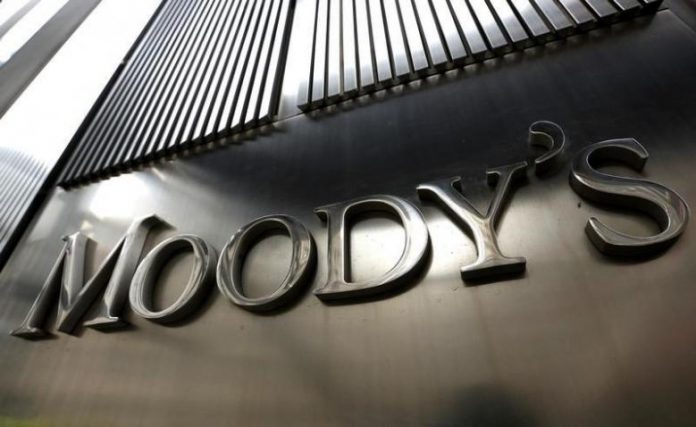
LAHORE: Moody’s in a report released on Thursday said Pakistan’s gross borrowing requirement was amongst the highest in its sovereign list, standing between 27 to 30 percent of GDP.
The report shared an appreciation of the dollar had caused a sharp currency depreciation and a major decline in foreign exchange reserves for emerging and frontier market countries.
The credit rating agency said Pakistan was facing increased external pressures arising from strong domestic and capital import heavy investments under China-Pakistan Economic Corridor (CPEC).
It projected the current account deficit for the financial year 2017-18 to be 4.2 percent of GDP and reserve coverage of external debt repayments was sufficient for now but projected it to erode.
It added until a major improvement in capital inflows wasn’t recorded, there was a high risk of foreign exchange reserves of further diminishing.
Moody’s report stated 30 percent of government debt was denominated in foreign currency and the country’s gross borrowing requirement was amongst the highest in its list, standing between 27 to 30 percent of GDP.
The credit rating agency highlighted this was fueled by persistent fiscal deficits and the government’s dependence on short-term debt, with an average maturity timeframe of 3.8 years.
Also, Moody’s said the country wasn’t a major recipient of volatile capital inflows and rupee depreciation to address external pressures could increase inflation and force further domestic rate hikes by the State Bank of Pakistan (SBP).
The hike in domestic rates by SBP would eventually be passed through to the government’s borrowing costs and further erode the government’s already fragile fiscal position, said Moody’s.
Earlier this month it was reported current account deficit in the first 11 months of 2017-18 amounted to $15.9 billion, up 43.2 per cent from the previous year.
According to data released by the central bank, the gap was $1.9 billion in May. This was nominally down from the preceding month, data showed.
The current account tracks a country’s overseas transactions, such as net trade, earnings on cross-border investments and transfer payments.
Exports of goods amounted to $22.8 billion in July-May, up 13.2 per cent from a year ago. However, the corresponding rise in imports which were worth $50.7 billion, remained 16.4 per cent over the same period.
Exports have mostly grown at a single-digit rate since 2010-11. A recovery in advanced economies from the second half of 2017 with the United States experiencing one of the fastest quarterly growth rates in the last three years, played a key role in the recent surge in exports, according to the SBP.
It boosted demand for products exported by emerging economies, including Pakistan, it said.
Last month, data released by SBP revealed Pakistan’s external debt and liabilities have risen over 50 percent or around $31 billion in nearly five years of the previous government’s tenure.
Adding insult to injury, Pakistan’s external debt and liabilities skyrocketed to a record high of $91.8 billion till the end of March and this figure for external debt and liabilities is 50.6 percent higher or increased by $30.9 billion compared to June 2013 when the PML-N took reins of the government.
From the total external debt and liabilities, government’s public debt including foreign exchange liabilities stood at $76.1 billion by end of March 2018.
Public debt linked obligations in almost five years’ time has risen by 42.5 percent or $22.7 billion, revealed SBP data.
According to the report, these currency variations reveal capital outflows or notably lower external inflows and termed them credit negative for sovereigns with huge external funding requirements.
Moody’s analyzed the vulnerability of a group of emerging and frontier markets to a strengthening US dollar and termed Pakistan (B3 negative) alongside Argentina (B2 stable), Ghana (B3 stable), Mongolia (B3 stable), Sri Lanka (B1 negative), Turkey (Ba2 RUR-), Zambia (B3 stable) the most vulnerable to a US dollar appreciation.
The report added nations with huge current account deficits, major foreign-currency government debt and high external repayments were the most susceptible.
Moody’s said “The US dollar has appreciated by nearly 6% in trade-weighted terms since mid-April, while capital flows to emerging markets have slowed. Although we expect only a moderate further appreciation of the US dollar, the US Federal Reserve’s balance sheet shrinking may have further implications for external financing conditions in emerging markets.”
“Economies rely on capital inflows to meet import payments and repay external debt. When risk appetite weakens, investors tend to their portfolios away from the economies most reliant on such capital inflows, in particular, those with low reserve buffers. In turn, lower capital inflows erode foreign exchange reserves, potentially starting a negative feedback loop”, said Moody’s.
And the credit rating agency added “In addition to the balance of payments considerations, governments with a large share of foreign currency-denominated debt will see their debt servicing costs increase when the local currency depreciates.
When debt affordability is already weak, and reliance on short-term debt high, refinancing a higher debt burden at higher costs exacerbates pressure on the sovereign’s fiscal strength. Moreover, when the central bank needs to raise interest rates in order to mitigate the depreciation of the currency, higher external financing costs spill over into higher domestic financing costs.”





